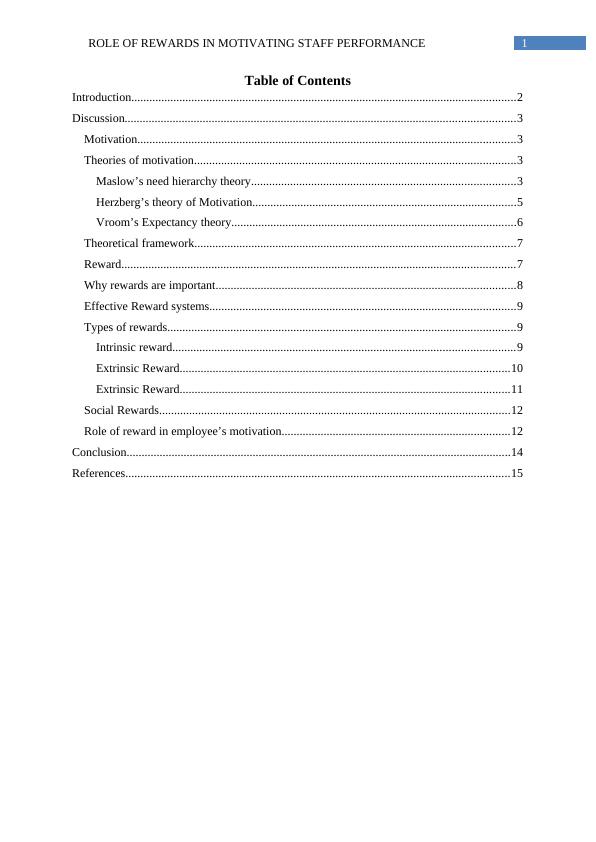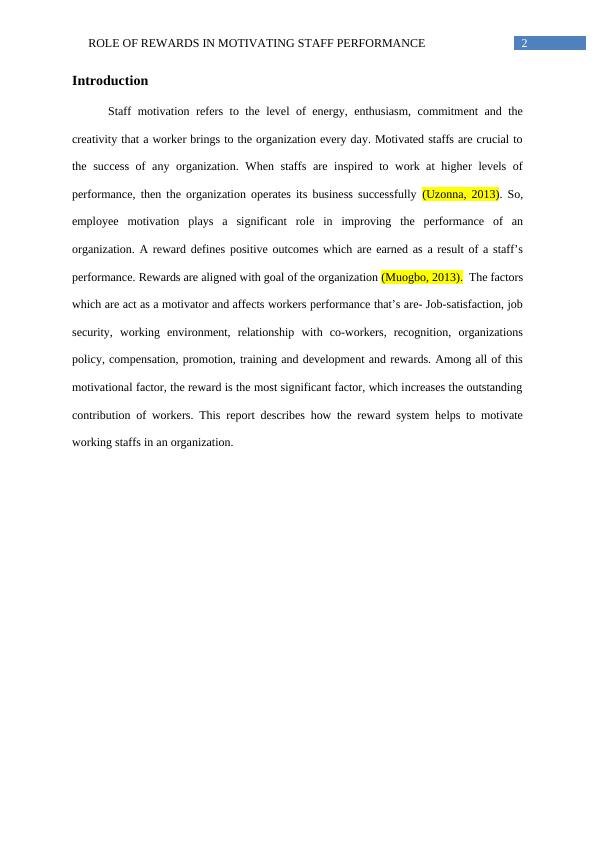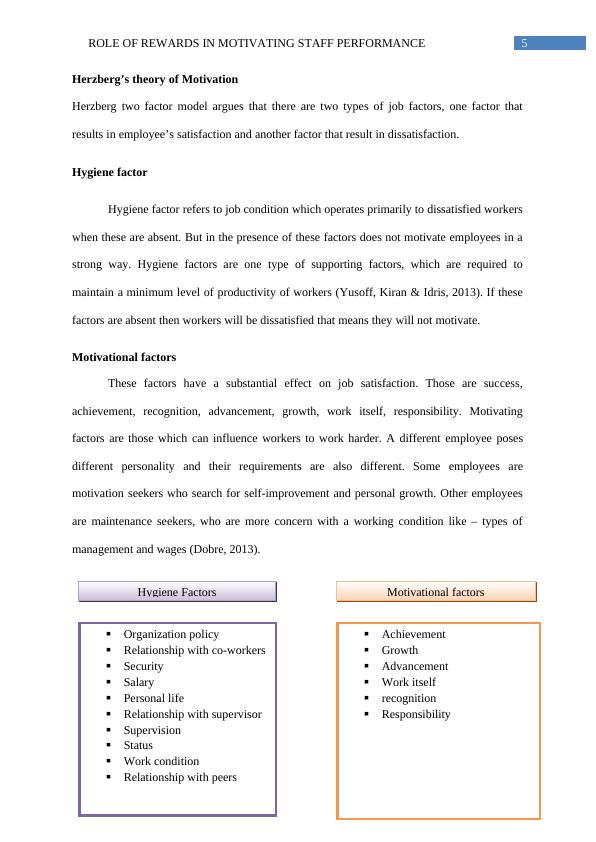Introduction to motivation theory
Added on 2022-10-19
22 Pages4381 Words384 Views
Running head: ROLE OF REWARDS IN MOTIVATING STAFF PERFORMANCE
ROLE OF REWARDS IN MOTIVATING STAFF PERFORMANCE
Name of the student
Name of the University
Author Note
ROLE OF REWARDS IN MOTIVATING STAFF PERFORMANCE
Name of the student
Name of the University
Author Note

1ROLE OF REWARDS IN MOTIVATING STAFF PERFORMANCE
Table of Contents
Introduction................................................................................................................................2
Discussion..................................................................................................................................3
Motivation..............................................................................................................................3
Theories of motivation...........................................................................................................3
Maslow’s need hierarchy theory........................................................................................3
Herzberg’s theory of Motivation........................................................................................5
Vroom’s Expectancy theory...............................................................................................6
Theoretical framework...........................................................................................................7
Reward...................................................................................................................................7
Why rewards are important....................................................................................................8
Effective Reward systems......................................................................................................9
Types of rewards....................................................................................................................9
Intrinsic reward..................................................................................................................9
Extrinsic Reward..............................................................................................................10
Extrinsic Reward..............................................................................................................11
Social Rewards.....................................................................................................................12
Role of reward in employee’s motivation............................................................................12
Conclusion................................................................................................................................14
References................................................................................................................................15
Table of Contents
Introduction................................................................................................................................2
Discussion..................................................................................................................................3
Motivation..............................................................................................................................3
Theories of motivation...........................................................................................................3
Maslow’s need hierarchy theory........................................................................................3
Herzberg’s theory of Motivation........................................................................................5
Vroom’s Expectancy theory...............................................................................................6
Theoretical framework...........................................................................................................7
Reward...................................................................................................................................7
Why rewards are important....................................................................................................8
Effective Reward systems......................................................................................................9
Types of rewards....................................................................................................................9
Intrinsic reward..................................................................................................................9
Extrinsic Reward..............................................................................................................10
Extrinsic Reward..............................................................................................................11
Social Rewards.....................................................................................................................12
Role of reward in employee’s motivation............................................................................12
Conclusion................................................................................................................................14
References................................................................................................................................15

2ROLE OF REWARDS IN MOTIVATING STAFF PERFORMANCE
Introduction
Staff motivation refers to the level of energy, enthusiasm, commitment and the
creativity that a worker brings to the organization every day. Motivated staffs are crucial to
the success of any organization. When staffs are inspired to work at higher levels of
performance, then the organization operates its business successfully (Uzonna, 2013). So,
employee motivation plays a significant role in improving the performance of an
organization. A reward defines positive outcomes which are earned as a result of a staff’s
performance. Rewards are aligned with goal of the organization (Muogbo, 2013). The factors
which are act as a motivator and affects workers performance that’s are- Job-satisfaction, job
security, working environment, relationship with co-workers, recognition, organizations
policy, compensation, promotion, training and development and rewards. Among all of this
motivational factor, the reward is the most significant factor, which increases the outstanding
contribution of workers. This report describes how the reward system helps to motivate
working staffs in an organization.
Introduction
Staff motivation refers to the level of energy, enthusiasm, commitment and the
creativity that a worker brings to the organization every day. Motivated staffs are crucial to
the success of any organization. When staffs are inspired to work at higher levels of
performance, then the organization operates its business successfully (Uzonna, 2013). So,
employee motivation plays a significant role in improving the performance of an
organization. A reward defines positive outcomes which are earned as a result of a staff’s
performance. Rewards are aligned with goal of the organization (Muogbo, 2013). The factors
which are act as a motivator and affects workers performance that’s are- Job-satisfaction, job
security, working environment, relationship with co-workers, recognition, organizations
policy, compensation, promotion, training and development and rewards. Among all of this
motivational factor, the reward is the most significant factor, which increases the outstanding
contribution of workers. This report describes how the reward system helps to motivate
working staffs in an organization.

3ROLE OF REWARDS IN MOTIVATING STAFF PERFORMANCE
Discussion
Motivation
Motivation is defined as a process of enhancing, stimulating and inducing the workers
to act effectively to obtain the certain goal of an organization. The term motivation originated
from the Latin word “mover” that means to move. It is a complex force starting a person to
work in an organization and continues him in the course of action already initiated (Jeffrey,
2019). It is a goal-oriented behavior.
Theories of motivation
Motivation theories are based on the needs of every individual. These theories
explain- motivation is an internal drive which encourages people to move toward the
satisfaction of needs.
Maslow’s need hierarchy theory
Maslow proposes that needs have an effective precedence. As the fundamental
requirements are fulfilled, then an individual seeks to meet higher-order needs.
Physiological needs
Physiological needs are the most powerful but basic needs that are necessary for
survival. An organization provides a salary or financial rewards to their employees. And this
way helps to satisfy an individual’s basic needs.
Safety needs
Safety needs reflect the desire for security. When physiological needs become
relatively satisfied, the security of safety needs begins to manifest and dominate human
Discussion
Motivation
Motivation is defined as a process of enhancing, stimulating and inducing the workers
to act effectively to obtain the certain goal of an organization. The term motivation originated
from the Latin word “mover” that means to move. It is a complex force starting a person to
work in an organization and continues him in the course of action already initiated (Jeffrey,
2019). It is a goal-oriented behavior.
Theories of motivation
Motivation theories are based on the needs of every individual. These theories
explain- motivation is an internal drive which encourages people to move toward the
satisfaction of needs.
Maslow’s need hierarchy theory
Maslow proposes that needs have an effective precedence. As the fundamental
requirements are fulfilled, then an individual seeks to meet higher-order needs.
Physiological needs
Physiological needs are the most powerful but basic needs that are necessary for
survival. An organization provides a salary or financial rewards to their employees. And this
way helps to satisfy an individual’s basic needs.
Safety needs
Safety needs reflect the desire for security. When physiological needs become
relatively satisfied, the security of safety needs begins to manifest and dominate human

4ROLE OF REWARDS IN MOTIVATING STAFF PERFORMANCE
behavior. Safety needs include protection from economic security, physical danger, health
insurance, desire for a safe environment.
Social needs
Each and every individual wants to get associated with others. It reflects the
individual desire for love and affection (Jeffrey, 2019). These all come under the category of
social needs. The organization fulfilled its employee’s social needs through parties and
celebrations. The management of the organization can help to motivate and satisfy their
worker's social needs by showing direct care and concern for workers.
Self-esteem needs
The esteems needs are concerned with self-confident, competence, achievement, self-
respect, need for status, knowledge, recognition and respect. These needs are not stable,
which are rarely satisfied. Neglecting of these needs cause – weakness, helplessness, feeling
of inferiority and worthlessness. And the fulfillment of these requirements produces feelings
of strength, control and self-confident. An organization fulfils its employee's self-esteem
needs by providing recognition (Taormina & Gao, 2013).
Self-actualization needs
Self-actualization refers to the growth and self-fulfillment of an individual. This
process is different for every individual. By assigning works that challenge workers mind and
motivating their aptitude, in this way an organization fulfill their worker's self-actualization
needs.
Abraham Maslow suggested that various levels of needs are independent and overlapping.
Each higher-order needs emerging before lower-order needs have been completely satisfied.
behavior. Safety needs include protection from economic security, physical danger, health
insurance, desire for a safe environment.
Social needs
Each and every individual wants to get associated with others. It reflects the
individual desire for love and affection (Jeffrey, 2019). These all come under the category of
social needs. The organization fulfilled its employee’s social needs through parties and
celebrations. The management of the organization can help to motivate and satisfy their
worker's social needs by showing direct care and concern for workers.
Self-esteem needs
The esteems needs are concerned with self-confident, competence, achievement, self-
respect, need for status, knowledge, recognition and respect. These needs are not stable,
which are rarely satisfied. Neglecting of these needs cause – weakness, helplessness, feeling
of inferiority and worthlessness. And the fulfillment of these requirements produces feelings
of strength, control and self-confident. An organization fulfils its employee's self-esteem
needs by providing recognition (Taormina & Gao, 2013).
Self-actualization needs
Self-actualization refers to the growth and self-fulfillment of an individual. This
process is different for every individual. By assigning works that challenge workers mind and
motivating their aptitude, in this way an organization fulfill their worker's self-actualization
needs.
Abraham Maslow suggested that various levels of needs are independent and overlapping.
Each higher-order needs emerging before lower-order needs have been completely satisfied.

5ROLE OF REWARDS IN MOTIVATING STAFF PERFORMANCE
Herzberg’s theory of Motivation
Herzberg two factor model argues that there are two types of job factors, one factor that
results in employee’s satisfaction and another factor that result in dissatisfaction.
Hygiene factor
Hygiene factor refers to job condition which operates primarily to dissatisfied workers
when these are absent. But in the presence of these factors does not motivate employees in a
strong way. Hygiene factors are one type of supporting factors, which are required to
maintain a minimum level of productivity of workers (Yusoff, Kiran & Idris, 2013). If these
factors are absent then workers will be dissatisfied that means they will not motivate.
Motivational factors
These factors have a substantial effect on job satisfaction. Those are success,
achievement, recognition, advancement, growth, work itself, responsibility. Motivating
factors are those which can influence workers to work harder. A different employee poses
different personality and their requirements are also different. Some employees are
motivation seekers who search for self-improvement and personal growth. Other employees
are maintenance seekers, who are more concern with a working condition like – types of
management and wages (Dobre, 2013).
Hygiene Factors Motivational factors
Organization policy
Relationship with co-workers
Security
Salary
Personal life
Relationship with supervisor
Supervision
Status
Work condition
Relationship with peers
Achievement
Growth
Advancement
Work itself
recognition
Responsibility
Herzberg’s theory of Motivation
Herzberg two factor model argues that there are two types of job factors, one factor that
results in employee’s satisfaction and another factor that result in dissatisfaction.
Hygiene factor
Hygiene factor refers to job condition which operates primarily to dissatisfied workers
when these are absent. But in the presence of these factors does not motivate employees in a
strong way. Hygiene factors are one type of supporting factors, which are required to
maintain a minimum level of productivity of workers (Yusoff, Kiran & Idris, 2013). If these
factors are absent then workers will be dissatisfied that means they will not motivate.
Motivational factors
These factors have a substantial effect on job satisfaction. Those are success,
achievement, recognition, advancement, growth, work itself, responsibility. Motivating
factors are those which can influence workers to work harder. A different employee poses
different personality and their requirements are also different. Some employees are
motivation seekers who search for self-improvement and personal growth. Other employees
are maintenance seekers, who are more concern with a working condition like – types of
management and wages (Dobre, 2013).
Hygiene Factors Motivational factors
Organization policy
Relationship with co-workers
Security
Salary
Personal life
Relationship with supervisor
Supervision
Status
Work condition
Relationship with peers
Achievement
Growth
Advancement
Work itself
recognition
Responsibility

End of preview
Want to access all the pages? Upload your documents or become a member.
Related Documents
Motivation Theories: Maslow, Vroom, and Herzberglg...
|7
|1785
|158
Understanding why people worklg...
|8
|2062
|293
Understanding Why People Work: Factors that Motivate Employees and Coping Strategieslg...
|8
|1958
|126
Theories of Motivation and Their Application in Modern Workplacelg...
|7
|1757
|204
Motivation in the Workplace: Understanding Why People Worklg...
|8
|2244
|325
Executive Master of Human Resource Management (EMHRM)lg...
|10
|2327
|23